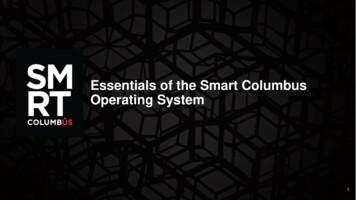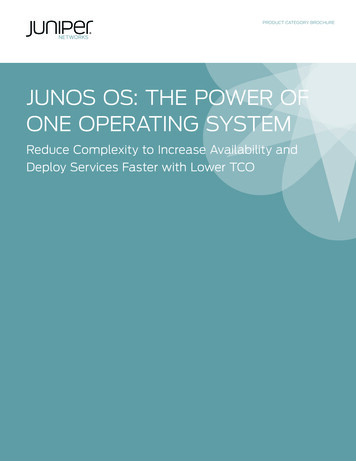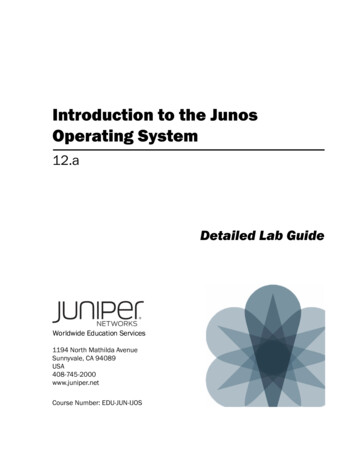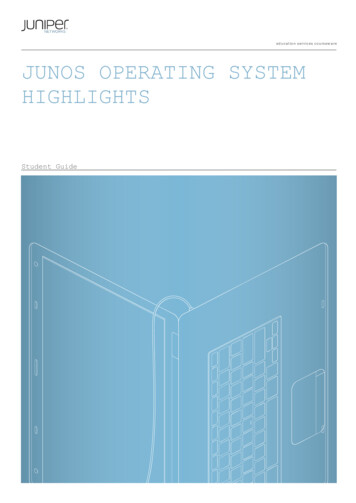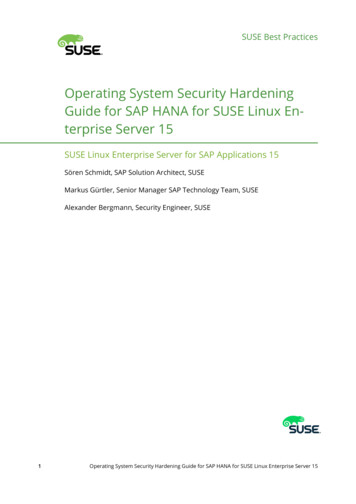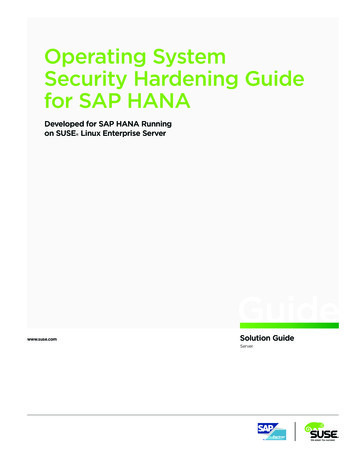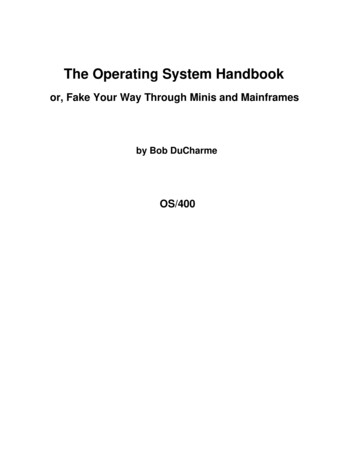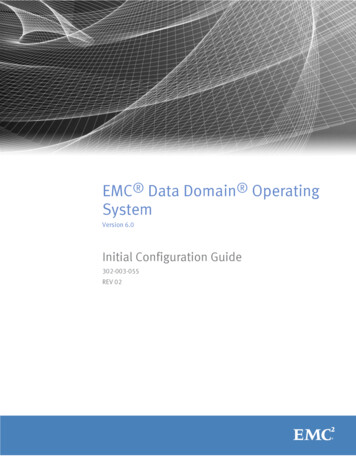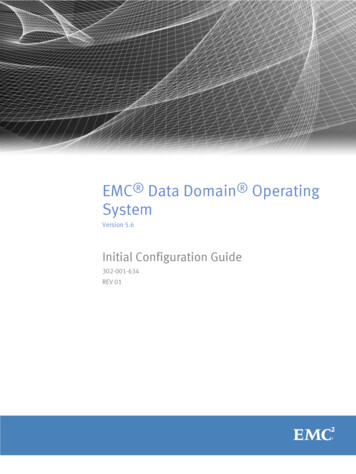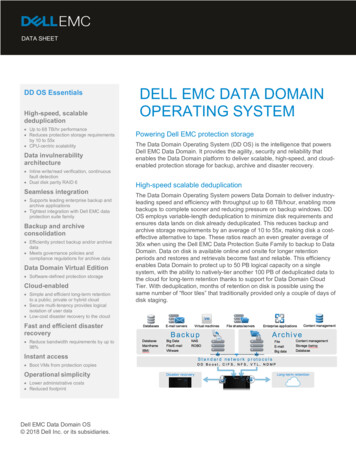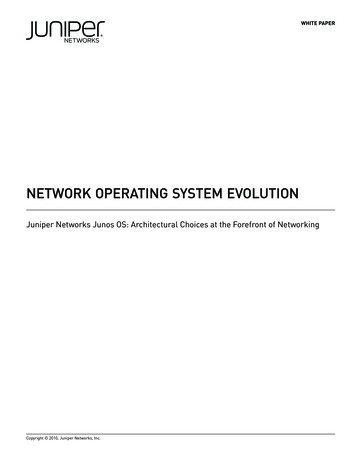
Transcription
WHITE PAPERNetwork Operating System EvolutionJuniper Networks Junos OS: Architectural Choices at the Forefront of NetworkingCopyright 2010, Juniper Networks, Inc.
WHITE PAPER - Network Operating System EvolutionTable of ContentsExecutive Summary . . . . . . . . . . . . . . . . . . . . . . . . . . . . . . . . . . . . . . . . . . . . . . . . . . . . . . . . . . . . . . . . . . . . . . . . . . . . . . . . . . 1Introduction . . . . . . . . . . . . . . . . . . . . . . . . . . . . . . . . . . . . . . . . . . . . . . . . . . . . . . . . . . . . . . . . . . . . . . . . . . . . . . . . . . . . . . . . . 1Origin and Evolution of Network Operating Systems. . . . . . . . . . . . . . . . . . . . . . . . . . . . . . . . . . . . . . . . . . . . . . . . . . . . . . . 1First-Generation OS: Monolithic Architecture . . . . . . . . . . . . . . . . . . . . . . . . . . . . . . . . . . . . . . . . . . . . . . . . . . . . . . . . 2Second-Generation OS: Control Plane Modularity . . . . . . . . . . . . . . . . . . . . . . . . . . . . . . . . . . . . . . . . . . . . . . . . . . . . 2Third-Generation OS: Flexibility, Scalability and Continuous Operation . . . . . . . . . . . . . . . . . . . . . . . . . . . . . . . . . . . 3Basic OS Design Considerations . . . . . . . . . . . . . . . . . . . . . . . . . . . . . . . . . . . . . . . . . . . . . . . . . . . . . . . . . . . . . . . . . . . . . . . . 3Commercial Versus Open-Source Donor OS . . . . . . . . . . . . . . . . . . . . . . . . . . . . . . . . . . . . . . . . . . . . . . . . . . . . . . . . . . 3Functional Separation and Process Scheduling . . . . . . . . . . . . . . . . . . . . . . . . . . . . . . . . . . . . . . . . . . . . . . . . . . . . . . . 4Memory Model . . . . . . . . . . . . . . . . . . . . . . . . . . . . . . . . . . . . . . . . . . . . . . . . . . . . . . . . . . . . . . . . . . . . . . . . . . . . . . . . . . 4Scheduling Discipline . . . . . . . . . . . . . . . . . . . . . . . . . . . . . . . . . . . . . . . . . . . . . . . . . . . . . . . . . . . . . . . . . . . . . . . . . . . . 4Virtual Memory/Preemptive Scheduling Programming Model . . . . . . . . . . . . . . . . . . . . . . . . . . . . . . . . . . . . . . . . . . . 4Generic Kernel Design. . . . . . . . . . . . . . . . . . . . . . . . . . . . . . . . . . . . . . . . . . . . . . . . . . . . . . . . . . . . . . . . . . . . . . . . . . . . . . . . 6Monolithic Versus Microkernel Network Operating System Designs . . . . . . . . . . . . . . . . . . . . . . . . . . . . . . . . . . . . . . 6Junos OS Kernel . . . . . . . . . . . . . . . . . . . . . . . . . . . . . . . . . . . . . . . . . . . . . . . . . . . . . . . . . . . . . . . . . . . . . . . . . . . . . . . . . . . . . 7Process Scheduling in Junos OS . . . . . . . . . . . . . . . . . . . . . . . . . . . . . . . . . . . . . . . . . . . . . . . . . . . . . . . . . . . . . . . . . . . 8Junos OS Routing Protocol Process . . . . . . . . . . . . . . . . . . . . . . . . . . . . . . . . . . . . . . . . . . . . . . . . . . . . . . . . . . . . . . . . . . . . . 9Scalability . . . . . . . . . . . . . . . . . . . . . . . . . . . . . . . . . . . . . . . . . . . . . . . . . . . . . . . . . . . . . . . . . . . . . . . . . . . . . . . . . . . . . . . . . 10Scaling Down . . . . . . . . . . . . . . . . . . . . . . . . . . . . . . . . . . . . . . . . . . . . . . . . . . . . . . . . . . . . . . . . . . . . . . . . . . . . . . . . . . 10Scaling Up . . . . . . . . . . . . . . . . . . . . . . . . . . . . . . . . . . . . . . . . . . . . . . . . . . . . . . . . . . . . . . . . . . . . . . . . . . . . . . . . . . . . . 11Architecture and Infrastructure . . . . . . . . . . . . . . . . . . . . . . . . . . . . . . . . . . . . . . . . . . . . . . . . . . . . . . . . . . . . . . . . . . . . . . . 12Parallelism . . . . . . . . . . . . . . . . . . . . . . . . . . . . . . . . . . . . . . . . . . . . . . . . . . . . . . . . . . . . . . . . . . . . . . . . . . . . . . . . . . . . 12Flexibility and Portability . . . . . . . . . . . . . . . . . . . . . . . . . . . . . . . . . . . . . . . . . . . . . . . . . . . . . . . . . . . . . . . . . . . . . . . . . 13Degrees of Modularity . . . . . . . . . . . . . . . . . . . . . . . . . . . . . . . . . . . . . . . . . . . . . . . . . . . . . . . . . . . . . . . . . . . . . . . . . . . 14Open Architecture. . . . . . . . . . . . . . . . . . . . . . . . . . . . . . . . . . . . . . . . . . . . . . . . . . . . . . . . . . . . . . . . . . . . . . . . . . . . . . . . . . . 14Product Maintenance . . . . . . . . . . . . . . . . . . . . . . . . . . . . . . . . . . . . . . . . . . . . . . . . . . . . . . . . . . . . . . . . . . . . . . . . . . . . . . . . 14Self-Healing . . . . . . . . . . . . . . . . . . . . . . . . . . . . . . . . . . . . . . . . . . . . . . . . . . . . . . . . . . . . . . . . . . . . . . . . . . . . . . . . . . . 14Troubleshooting . . . . . . . . . . . . . . . . . . . . . . . . . . . . . . . . . . . . . . . . . . . . . . . . . . . . . . . . . . . . . . . . . . . . . . . . . . . . . . . . 15Quality and Reliability. . . . . . . . . . . . . . . . . . . . . . . . . . . . . . . . . . . . . . . . . . . . . . . . . . . . . . . . . . . . . . . . . . . . . . . . . . . . . . . . 16System Integrity . . . . . . . . . . . . . . . . . . . . . . . . . . . . . . . . . . . . . . . . . . . . . . . . . . . . . . . . . . . . . . . . . . . . . . . . . . . . . . . . 16Release Process Summary . . . . . . . . . . . . . . . . . . . . . . . . . . . . . . . . . . . . . . . . . . . . . . . . . . . . . . . . . . . . . . . . . . . . . . . 18Final Product Quality and Stability . . . . . . . . . . . . . . . . . . . . . . . . . . . . . . . . . . . . . . . . . . . . . . . . . . . . . . . . . . . . . . . . . . . . . 19Conclusion. . . . . . . . . . . . . . . . . . . . . . . . . . . . . . . . . . . . . . . . . . . . . . . . . . . . . . . . . . . . . . . . . . . . . . . . . . . . . . . . . . . . . . . . . 19What Makes Junos OS Different . . . . . . . . . . . . . . . . . . . . . . . . . . . . . . . . . . . . . . . . . . . . . . . . . . . . . . . . . . . . . . . . . . . . . . . 20About Juniper Networks. . . . . . . . . . . . . . . . . . . . . . . . . . . . . . . . . . . . . . . . . . . . . . . . . . . . . . . . . . . . . . . . . . . . . . . . . . . . . . 21iiCopyright 2010, Juniper Networks, Inc.
WHITE PAPER - Network Operating System EvolutionTable of FiguresFigure 1: Typical preemptive scheduling sequence. . . . . . . . . . . . . . . . . . . . . . . . . . . . . . . . . . . . . . . . . . . . . . . . . . . . . . . . 4Figure 2: Resource management conflicts in preemptive scheduling. . . . . . . . . . . . . . . . . . . . . . . . . . . . . . . . . . . . . . . . . 5Figure 3: Generic Junos OS 9.0 architectural structure . . . . . . . . . . . . . . . . . . . . . . . . . . . . . . . . . . . . . . . . . . . . . . . . . . . . 7Figure 4: Multilevel CPU scheduling in Junos OS. . . . . . . . . . . . . . . . . . . . . . . . . . . . . . . . . . . . . . . . . . . . . . . . . . . . . . . . . . 8Figure 5: Hierarchical protocol stack operation. . . . . . . . . . . . . . . . . . . . . . . . . . . . . . . . . . . . . . . . . . . . . . . . . . . . . . . . . . . 9Figure 6: Typical CPU times capture (from NEC 8800 product documentation). . . . . . . . . . . . . . . . . . . . . . . . . . . . . . . . 12Figure 7: Product consolidation under a common operating system . . . . . . . . . . . . . . . . . . . . . . . . . . . . . . . . . . . . . . . . 13Copyright 2010, Juniper Networks, Inc.iii
WHITE PAPER - Network Operating System EvolutionExecutive SummaryThis paper discusses the requirements and challenges inherent in the design of a carrier-class network operatingsystem (OS). Key facets of Juniper Networks Junos operating system, Juniper’s network operating system,are used to illustrate the evolution of OS design and underscore the relationship between functionality andarchitectural decisions.The challenge of designing a contemporary network operating system is examined from different angles, includingflexibility, ability to power a wide range of platforms, nonstop operation, and parallelism. Architectural challenges,trade-offs and opportunities are identified, as well as some of the best practices in building state-of-the-art networkoperating systems.IntroductionModern network devices are complex entities composed of both silicon and software. Thus, designing an efficienthardware platform is not, by itself, sufficient to achieve an effective, cost-efficient and operationally tenable product.The control plane plays a critical role in the development of features and in ensuring device usability.Although progress from the development of faster CPU boards and forwarding planes is visible, structural changesmade in software are usually hidden, and while vendor collateral often offers a list of features in a carrier-classpackage, operational experiences may vary considerably.Products that have been through several generations of software releases provide the best examples of thedifference made by the choice of OS. It is still not uncommon to find routers or switches that started life underolder, monolithic software and later migrated to more contemporary designs. The positive effect on stability andoperational efficiency is easy to notice and appreciate.However, migration from one network operating system to another can pose challenges from nonoverlapping featuresets, noncontiguous operational experiences and inconsistent software quality. These potential challenges make it isvery desirable to build a control plane that can power the hardware products and features supported in both currentand future markets.Developing a flexible, long-lasting and high-quality network OS provides a foundation that can gracefully evolve tosupport new needs in its height for up and down scaling, width for adoption across many platforms, and depth forrich integration of new features and functions. It takes time, significant investment and in-depth expertise.Most of the engineers writing the early releases of Junos OS came from other companies where they had previouslybuilt network software. They had firsthand knowledge of what worked well, and what could be improved. Theseengineers found new ways to solve the limitations that they’d experienced in building the older operating systems.Resulting innovations in Junos OS are significant and rooted in its earliest design stages. Still, to ensure that ourproducts anticipate and fulfill the next generation of market requirements, Junos OS is periodically reevaluated todetermine whether any changes are needed to ensure that it continues to provide the reliability, performance andresilience for which it is known.Origin and Evolution of Network Operating SystemsContemporary network operating systems are mostly advanced and specialized branches of POSIX-compliantsoftware platforms and are rarely developed from scratch. The main reason for this situation is the high cost ofdeveloping a world-class operating system all the way from concept to finished product. By adopting a generalpurpose OS architecture, network vendors can focus on routing-specific code, decrease time to market, and benefitfrom years of technology and research that went into the design of the original (donor) products.For example, consider Table 1, which lists some operating systems for routers and their respective origins (theGeneration column is explained in the following sections).Copyright 2010, Juniper Networks, Inc.1
WHITE PAPER - Network Operating System EvolutionTable 1: Router Operating System OriginsVENDORROUTER OSDONOR OSDONOR OSOWNERGENERATIONDONOR OS WEBSITEJuniperNetworksJunos OSFreeBSDInternet community2, 3www.freebsd.orgCiscoIOS-XRQNXQNX n/aCiscoIOS-XEIOS, LinuxHybrid (ASR)1.5n/aCiscoModular IOSIOS, QNXHybrid (6500)1.5n/aAlcatel-Lucent SR BSDInternet community2www.netbsd.orgForce10FTOSNetBSDInternet ernet community2www.xoslinux.orgGenerally speaking, network operating systems in routers can be traced to three generations of development, eachwith distinctively different architectural and design goals.First-Generation OS: Monolithic ArchitectureTypically, first-generation network operating systems for routers and switches were proprietary images running ina flat memory
Key facets of Juniper Networks Junos operating system, Juniper’s network operating system, are used to illustrate the evolution of OS design and underscore the relationship between functionality and architectural decisions. The challenge of designing a contemporary network operating system is examined from different angles, including flexibility, ability to power a wide range of platforms .

